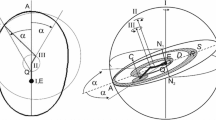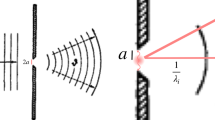Abstract
In several of his writings, Isaac Newton proposed that physical space is God’s “emanative effect” or “sensorium,” revealing something interesting about the metaphysics underlying his mathematical physics. Newton’s conjectures depart from Plato and Aristotle’s metaphysics of space and from classical and Cambridge Neoplatonism. Present-day philosophical concepts of supervenience clarify Newton’s ideas about space and offer a portrait of Newton not only as a mathematical physicist but an independent-minded rationalist philosopher.


Similar content being viewed by others
References
Isaac Newton, The Method of Fluxions and Infinite Series, ed. trans. John Colson (London: J. Nourse, 1736); Charles Hayes, A Treatise of Fluxions (London: Midwinter, 1704); Colin Maclaurin, A Treatise of Fluxions, in Two Books, Philosophical Transactions of the Royal Society, 42 (1744), 325–363 (Book I); 403–415 (Book II). Useful overviews include Florian Cajori, A History of the Conceptions of Limits and Fluxions in Great Britain from Newton to Woodhouse (Chicago: Open Court, 1919); Carl B. Boyer, The History of the Calculus and its Conceptual Development (New York: Dover, 1954).
Newton, General Scholium, Principia Mathematica Philosophiæ Naturalis, trans. I. Bernard Cohen and Anne Whitman (Berkeley: University of California Press, 1999), 943.
Plato, Timaeus 28–29a.
My trusted sources include R. T. Wallis, Neoplatonism, 2nd ed. (Indianapolis: Hackett Publishing Co., Inc., 1995); Paulina Remes, Neoplatonism (Berkeley: University of California Press, 2008); Svetla Slaveva Griffin and Paulina Remes, eds., The Routledge Handbook of Neoplatonism (London: Routledge, 2014); Arthur O. Lovejoy, The Great Chain of Being: A Study in the History of an Idea (New York: Harper & Row, Publishers, 1960).
Alexandre Koyré, From the Closed World to the Infinite Universe (Baltimore: The Johns Hopkins Press, 1957), 126–160.
See Jasper William Reid, “The Evolution of Henry More’s Theory of Divine Absolute Space,” Journal of the History of Philosophy 45 (2007), 79–102.
Likewise, Spinoza talking about substance does not make him an Aristotelian. J. E. Power, “Henry More and Isaac Newton on Absolute Space,” Journal of the History of Ideas 31 (1970), 289–296.
Newton may have been weakened but did not die from his alchemical experiments, but from a kidney stone. L. W. Johnson and M. L. Wolbarsht, “Mercury Poisoning: A Probable Cause of Isaac Newton’s Physical and Mental Ills,” Notes and Records of the Royal Society of London 34 (1979), 1–9. The aftermath following Newton’s death is examined in detail by Richard S. Westfall, Never at Rest: A Biography of Isaac Newton (Cambridge: Cambridge University Press, 1980), 815–874.
Among many other valuable sources on this topic, and in addition to the period philosophers mentioned, see Kasper von Geyerz, Religion and Culture in Early Modern Europe, 1500–1800 (Oxford: Oxford University Press, 2007).
Also, why is everything in motion? Why, for that matter, is anything in motion, moving from one place to another? Neoplatonism has the interesting option of answering that it is the nature of the Good or the choice of God as Godhead or unified Principle of Being to create the physical universe by having all Being emanate forth from its single centralized ontic font, in which everything is in motion by virtue of being an emanative effect. Newton rejects this explanatory model, while retaining some of the unique Neoplatonic framework of concepts and terminology, as he also does in redefining the metaphysics of physical space as God’s sensorium.
Isaac Newton, De Gravitatione et æquipondio fluridorum, in Newton, Philosophical Writings, ed. Andrew Janiak, trans. A. R. Hall and Marie Boas Hall (Cambridge: Cambridge University Press, 2004), 21.
Ibid., 25.
Ibid., 26. On Newton’s metaphysics and reluctance to use the word “metaphysics,” see Howard Stein, “Newton’s Metaphysics,” in I. B. Cohen and G. E. Smith, eds., The Cambridge Companion to Newton, (Cambridge: Cambridge University Press, 2002), 256–307; Dale Jacquette, “Aesthetics and Natural Law in Newton’s Methodology,” Journal of the History of Ideas 51 (1990), 659–666.
See John Tull Baker, “Space, Time, and God,” The Philosophical Review 41 (1932), 577–593; Koyré, From the Closed World to the Infinite Universe (ref. 6), 125–272; especially his discussion of Henry More, Nicolas Malebranche, Joseph Raphson, George Berkeley and Newton. Robert Rynasiewicz, “By Their Properties, Causes and Effects: Newton’s Scholium on Time, Space, Place, and Motion — i. The Text,” Studies in History and Philosophy of Science A 26 (1995), 133–153; Rynasiewicz, “By Their Properties, Causes and Effects: Newton’s Scholium on Time, Space, Place, and Motion — ii. The Context, Studies in History and Philosophy of Science B 26 (1995), 295–3221; Robert DiSalle, “Newton’s Philosophical Analysis of Space and Time,” in Cambridge Companion to Newton (ref. 15), 33–56; Andreas Blank, “Existential Dependence and the Question of Emanative Causation in Protestant Metaphysics,” Intellectual History Review 19 (2009), 1–13; Eric Schliesser, “Newtonian Emanation, Spinozism, Measurement and the Baconian Origins of the Laws of Nature,” Foundations of Science 18 (2013), 449–466.
Henry More, An Antidote Against Atheism, 2nd ed. (London: J. Flesher, 1655); More, The Immortality of the Soul (London: J. Flesher, 1659); More, Enchiridion Metaphysicum (London: E. Flesher, 1671). Only More’s Enchiridion would have appeared after Newton wrote De Gravitatione and certainly all of these books in More’s large repertoire would have been circulating before Newton wrote answers to the Queries in later editions of the Opticks.
Koyré, From the Closed World to the Infinite Universe (ref. 5) 159.
Ibid., 190.
Ibid., 220. See also J. E. McGuire, “Newton on Place, Time, and God: An Unpublished Source,” British Journal for the History of Science 11 (1978), 114–129.
Aristotle, Physics 194b16–195a27; Metaphysics 1013a24–1014a16, and De Partibus Animalium 639b12–15.
Newton, Opticks (New York: Dover, 1952), 402.
Ibid., 402–403.
Johann Wolfgang von Goethe, The Metamorphosis of Plants (Cambridge, MA: MIT Press, 2009).
Thomas Kuhn, The Structure of Scientific Revolutions (Chicago: University of Chicago Press, 1962).
See Geoffrey Gorham, “God and the Natural World in the Seventeenth Century: Space, Time, and Causality,” Philosophy Compass 4 (2009), 859–872; Gorham, “Newton on God’s Relation to Space and Time: The Cartesian Framework,” Archiv für Geschichte der Philosophie 93 (2011), 281–320; J. E. McGuire, “Predicates of Pure Existence: Newton on God’s Space and Time,” in Philosophical Perspectives on Newtonian Science, ed. Phillip Bricker and R. I. G. Hughes (Cambridge: Cambridge University Press, 1990), 91–108; Edward Slowik, “Newton’s Metaphysics of Space: A ‘Tertium Quid’ betwixt Substantivalism and Relationism, or Merely a 'God of the (Rational Mechanical) Gaps'?” Perspectives on Science 17 (2009), 429–456.
Ibid., 404–405.
On the concept of supervenience, with applications especially in the philosophy of mind, see Jaegwon Kim, Supervenience and Mind: Selected Philosophical Essays (Cambridge: Cambridge University Press, 1993), who distinguishes between weak and strong supervenience (53–78); see also Elias E. Savellos and Umit D. Yalcin, eds., Supervenience: New Essays (Cambridge: Cambridge University Press, 1995).
Ibid., 403. See Ayval Lesham, Newton on Mathematics and Spiritual Purity (Berlin: Springer Verlag, 2003), 78–80.
Samuel Clarke’s Latin translation of the original English edition of Newton’s (1704) Opticks was publised as Optice: Sive de reflexionibus, refractionibus, inflexionibus & coloribus lucis (London: William and John Innys, 1706). I was originally drawn to this source by an on-line translation and commentary of the Clark edition by George MacDonald Ross, on a website that seems to have been deactivated. I hope to avoid both offending Ross and violating copyright or other intellectual property right in quoting from this part of his once public domain translation.
Ibid.
I. C. Tipton, Berkeley: The Philosophy of Immaterialism (London: Taylor & Francis, 1974), 117, discusses some of the difficulties of attribution of the famous formula to any of Berkeley’s writings. Nicholas Malebranche should also be mentioned in this connection, despite essential differences from Berkeley.
Newton, Opticks (ref. 20), 370.
See Jacquette, “Zeno of Citium on the Divinity of the Cosmos,” Studies in Religion/Sciences Religieuses 24 (1995), 415–431.
Newton, De Gravitatione (ref. 11), 26.
Ibid.
This pantheistic view goes back to the Stoics, beginning with Zeno of Citium, later maintained by Spinoza and in an idealist variant Nicolas Malebranche; see Jacquette, “Zeno” (ref. 32).
Acknowledgments
A version of this essay was presented at a workshop on alternative concepts of causation, Universiteit Leiden, The Netherlands, April 10–11, 2009, under the title “Newton’s Noncausal Concept of Emanative Effect.” I am grateful to workshop participants for useful comments and to an anonymous referee of the present journal for invaluable suggestions for improvement.
Author information
Authors and Affiliations
Corresponding author
Additional information
Dale Jacquette is Senior Professorial Chair of Logic and Theoretical Philosophy, University of Bern, Switzerland. He has authored and edited many books and published many articles in logic, metaphysics, philosophy of science, philosophy of religion, and history of philosophy.
Rights and permissions
About this article
Cite this article
Jacquette, D. Newton’s Metaphysics of Space as God’s Emanative Effect. Phys. Perspect. 16, 344–370 (2014). https://doi.org/10.1007/s00016-014-0142-8
Published:
Issue Date:
DOI: https://doi.org/10.1007/s00016-014-0142-8




